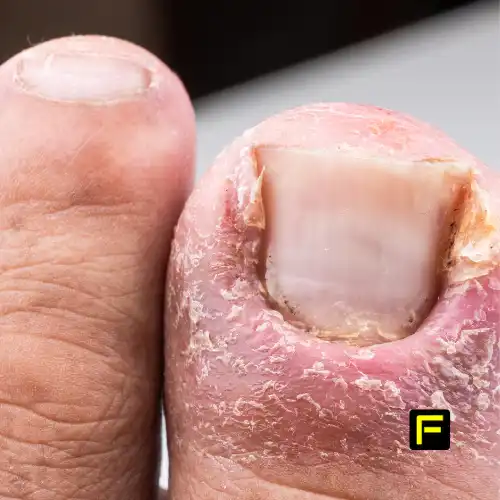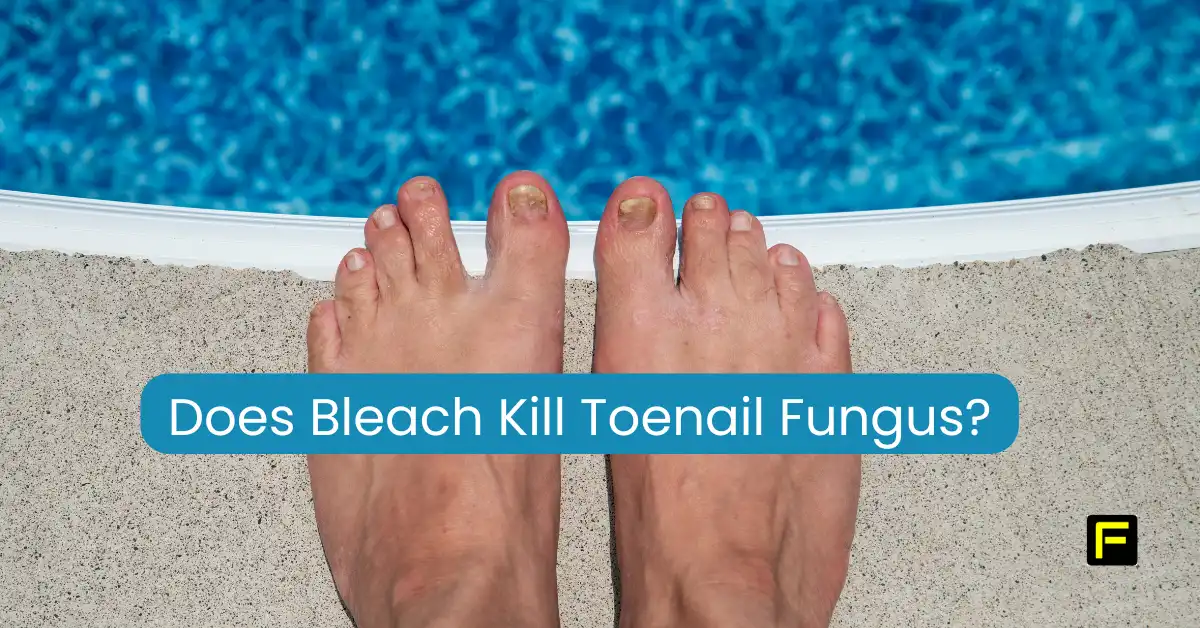Summer is here, and that means sandals, beach trips, and exposed feet. But if you’re dealing with toenail fungus, you might feel too embarrassed to show your feet in public. One of the most common questions I hear from readers is “Does bleach kill toenail fungus?” This DIY remedy has gained popularity online, but does the science support it? Today, I’m diving deep into what actually works for this stubborn and common condition.

Table of Contents
Key Takeaways
Before we dive into the details, here are the three most important things you need to know:
- Bleach is ineffective and potentially harmful for treating toenail fungus. While it kills surface fungi, it can’t penetrate the nail to reach the infection’s source and may actually damage your skin, creating more entry points for fungi.
- Prescription oral antifungals are the most effective treatment, with success rates of 70-80% for medications like terbinafine (Lamisil). Over-the-counter options have much lower success rates but may help with very mild cases.
- Patience is essential – even with the most effective treatments, complete clearing takes 9-12 months as the healthy nail grows out. There are no instant cures for toenail fungus despite what some products claim.
What Is Toenail Fungus and Why Is It So Common?
Toenail fungus, medically known as onychomycosis, affects approximately 36 million Americans and about 10% of the general population. Among adults over 70, that number jumps to nearly 50%! The prevalence increases with age because our nails grow more slowly and become more vulnerable to infection as we get older.
The condition presents as:
- Yellow, brown, or white discoloration of the nail
- Thickening and distortion of the nail shape
- Brittle, crumbly, or ragged edges
- Sometimes pain or discomfort when pressure is applied
- A distinct odor in some cases
Fungi called dermatophytes are the most common culprits, though yeasts and molds can also cause infections. These microscopic organisms thrive in warm, moist environments and can enter through tiny cracks in your nail or the surrounding skin.
Toenail Fungus Development: A Gradual Process
Fungal nail infections don’t appear overnight. The infection begins subtly—often as a small white or yellow spot under the nail tip. Over weeks or months, it spreads deeper, making the nail discolored, thickened, and crumbly. By the time most people notice they have a problem, the fungus has established a stubborn foothold.
Is Toenail Fungus Contagious?
Yes, toenail fungus is definitely contagious. The fungi that cause these infections can spread through:
- Direct skin-to-skin contact
- Shared shoes, socks, or nail tools
- Contaminated surfaces in showers and locker rooms
- Swimming pool decks and communal bathing areas
This contagious nature is why public swimming pools and gym showers are common sites for picking up the infection. It’s also why a single infected family member can sometimes lead to multiple cases in a household.
The Connection Between Athlete’s Foot and Toenail Fungus
Athlete’s foot and toenail fungus share a close relationship. In fact, about one-third of people with athlete’s foot will develop toenail fungus if left untreated. They’re typically caused by the same group of fungi (dermatophytes), but affect different parts of the foot.
Athlete’s foot (tinea pedis) primarily affects the skin, particularly between the toes. If not properly treated, the infection can spread to the toenails. This is why treating any skin-based fungal infection promptly is crucial for preventing more stubborn nail infections.
Risk Factors for Developing Toenail Fungus
Several factors increase your susceptibility:
Environmental Factors
- Frequent exposure to moist environments (public showers, pools)
- Hot, humid climate (fungi thrive in warmth and moisture)
- Communal living situations (dormitories, military barracks)
Personal Factors
- Wearing tight, non-breathable shoes that trap moisture
- Excessive sweating
- Minor nail injuries or skin conditions around the nail
- Weakened immune system from medications or conditions
- Diabetes (reduced circulation to extremities)
- Age (slower nail growth creates more opportunity for infection)
- Genetic predisposition (some people are simply more susceptible)
The Science Behind Bleach: Can It Actually Kill Toenail Fungus?
Now for the big question: Does bleach kill toenail fungus in real-world applications?
In theory, bleach (sodium hypochlorite) is a potent disinfectant that can kill many microorganisms on contact. However, there are several critical scientific limitations when it comes to treating toenail fungus:
- Poor Penetration: Toenail fungus resides deep within and underneath the nail plate. Bleach cannot effectively penetrate the dense keratin structure of the nail to reach the fungus living in the nail bed where the infection actually lives.
- Damage to Healthy Tissue: According to medical research, bleach can actually increase the risk of fungal infections by damaging the skin and nails, creating new entry points for fungi.
- Inconsistent Concentration: Home dilutions of bleach are rarely precise, leading to solutions that are either too weak to be effective or too strong and potentially harmful.
- Temporary Surface Action: Even if bleach kills some surface fungi, it doesn’t address the root of the infection beneath the nail, meaning any improvement is superficial and temporary.
While some people claim success with diluted bleach foot soaks (typically 1 tablespoon per gallon of water for 10-30 minutes), medical professionals generally advise against using bleach, as it can irritate and dry the skin, potentially causing chemical burns.
Using bleach in shower cleaning may help prevent spreading the fungus to others but won’t treat an existing infection effectively.
Most Effective Treatments for Toenail Fungus (Based on Scientific Evidence)
Instead of risking damage with bleach, consider these proven treatments, ranked from most to least effective based on clinical studies:
Prescription Oral Antifungals
The most effective treatments are prescription oral medications. Studies show that after a three-month treatment with terbinafine, about 76% of patients were clear of infection after one year, compared to only 17% who didn’t receive this treatment.
Top options include:
- Terbinafine (Lamisil) – The gold standard with the highest cure rate (70-80%). Usually taken daily for 6-12 weeks.
- Pros: Most effective option, continues working after treatment ends
- Cons: Requires liver function monitoring, potential side effects like headache or rash
- Itraconazole (Sporanox) – Another effective option with a 43% cure rate after one year.
- Pros: Can be taken in “pulse” therapy (one week per month)
- Cons: More drug interactions than terbinafine, less effective overall
- Fluconazole (Diflucan) – Taken weekly rather than daily.
- Pros: Less frequent dosing
- Cons: Lower efficacy than the options above
Prescription Topical Treatments
Newer prescription topical solutions can be effective for mild to moderate infections:
- Efinaconazole (Jublia) – A nail solution applied daily to affected nails.
- Pros: Minimal side effects, no systemic absorption
- Cons: Expensive, requires daily application for up to 48 weeks
- Tavaborole (Kerydin) – Another topical solution with similar properties.
- Pros: Better penetration than older topicals
- Cons: Treatment can last up to 48 weeks, expensive
- Ciclopirox (Penlac) – Nail lacquer applied daily, then removed weekly.
- Pros: Well-established safety profile
- Cons: Less effective than newer topicals, complicated application process
Over-the-Counter Options

While less effective than prescription treatments, these may help with very mild cases:
- NONYX Fungal Nail Clarifying Gel – Contains ingredients that help remove keratin debris where fungus grows.
- Products with Undecylenic Acid – This ingredient has antifungal properties and is found in several OTC products like FungiCure.
- Tea Tree Oil – Has natural antifungal properties. Studies show it may perform similarly to some topical treatments for mild cases.
- Vicks VapoRub – Contains camphor and eucalyptus oil, which have some antifungal properties. A small study found it had “positive clinical effect” in treating toenail fungus.
Medical Procedures
For severe or resistant cases, procedural interventions may be necessary:
- Laser Treatment – Uses targeted light energy to kill fungi without damaging surrounding tissue.
- Pros: No systemic side effects, typically painless
- Cons: Expensive, often not covered by insurance, variable results
- Nail Removal – Temporary or permanent removal of the infected nail.
- Pros: Allows direct treatment of the nail bed, high efficacy for severe cases
- Cons: Invasive, recovery time, potential for nail deformity when it regrows
- Debridement – Professional thinning and trimming of infected nails to reduce fungal burden.
- Pros: Can be combined with other treatments for better results
- Cons: Not a standalone cure, requires professional care
Preventing Toenail Fungus: Effective Strategies
The best treatment is prevention. Here are science-backed strategies:
- Keep feet clean and thoroughly dry, especially between toes
- Wear moisture-wicking socks made of synthetic fibers or merino wool (avoid cotton)
- Choose breathable footwear with adequate toe space
- Disinfect shoes regularly using UV shoe sanitizers or antifungal sprays
- Use shower shoes or sandals in public pools, gyms, and hotel bathrooms
- Don’t share nail tools, footwear, or socks
- Treat athlete’s foot promptly before it can spread to nails
- Sanitize nail tools between uses with 70% isopropyl alcohol
- Choose nail salons that properly sterilize equipment
- Consider preventive topical antifungals if you’re prone to infections
Managing Moisture: The Key to Prevention
Controlling foot moisture is perhaps the most crucial preventive measure:
- Alternate shoes daily to allow 24-hour drying periods
- Use moisture-absorbing foot powders containing ingredients like zinc oxide or talc
- Consider silica gel shoe inserts to absorb excess moisture
- Apply antiperspirant to feet if you experience excessive sweating
- Change socks at least once daily, or more if your feet sweat heavily
Treatment Timeline: Setting Realistic Expectations
Patience is essential with any treatment approach. Nail fungus treatments work slowly, and improvement will continue AFTER therapy is stopped. Complete clearing typically takes:
- 6-12 weeks for initial improvement with oral medications
- 9-12 months to see full results as the healthy nail grows out
- Up to 48 weeks for topical treatments to show maximum efficacy
Even after successful treatment, recurrence rates can be high (10-50%) without proper preventive measures.
When to See a Healthcare Professional
Consult a podiatrist or dermatologist if:
- Your infection doesn’t improve with over-the-counter treatments
- You have diabetes, circulation problems, or a compromised immune system
- You experience pain, spreading redness, or warmth around the nail
- The nail becomes severely damaged or separated from the nail bed
- You have a history of recurrent infections
The Bottom Line on Bleach and Toenail Fungus
While bleach may kill fungus in laboratory settings, it’s not an effective or safe treatment for infected toenails in real-world applications. Any progress that bleach makes in treating toenail fungus is only temporary and comes with significant risks to healthy tissue.
Instead, focus on:
- Consulting a healthcare provider for proper diagnosis
- Using proven medical treatments appropriate for your infection severity
- Implementing consistent preventive measures to avoid recurrence
Remember, you’re not alone in this struggle. With proper treatment and a little patience, you can restore the health and appearance of your nails and enjoy sandal season with confidence again.
Have you struggled with toenail fungus? What treatments worked for you? Share your experience in the comments below!

Claudia Faucher is a full-time fitness training expert and lifestyle blogger. She is also been a certified Les Mills BodyPump instructor for the past 5 years and a fitness instructor for over 20 years. Claudia is a personal trainer and creates fitness training programs for seniors and people of all ages. She likes to use her skills and experiences to help others on their fitness journeys.
Last update on 2025-12-27 / Affiliate links / Images from Amazon Product Advertising API
